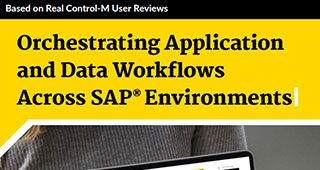For many enterprises, SAP® can be one the most significant IT investments. Companies that use SAP rely on the software to keep their businesses running. It’s critical, therefore, for SAP landscapes to function properly while keeping administrative costs as low as reasonably possible. To realize these objectives, it makes sense to have a solid application and data workflow orchestration strategy and platform.
A new Peer Paper from PeerSpot explores this issue, based on real user experiences by PeerSpot members who use Control-M from BMC. As users describe in the paper, orchestrating application and data workflows across SAP environments requires a platform that can optimize workflows and provide extensive visibility and control. The platform also needs to streamline workflows and data pipelines while enabling efficient management and improved performance.
Optimize Workflows
IT resources are always at a premium. IT managers therefore prize the ability to optimize workflows. As a Maintenance Manager at a transportation company who schedules the majority of his team’s SAP jobs on Control-M said, “We are optimizing, saving money for the customers and ourselves, while reducing the number of executions, jobs, etc.” He then shared, “We are definitely seeing more value in reporting on the batch schedules, optimizing it and seeing if we can cut costs.”
He added, “We do that globally for all the production plants. We have tens of thousands of SAP jobs and managed file transfer. SAP batch and managed file transfer are critical processes that we have automated.” They are in the process of replacing their legacy file transfer solution with Managed File Transfer (MFT) on a global scale.
Complete Visibility
Team members who are responsible for orchestrating application and data workflows across SAP need to know what’s happening at all times. Complete visibility into workflows is essential. To this point, the transportation company’s Maintenance Manager said, “With Control-M, you get visibility on your file transfers and how it mostly interacts with your batch schedule. Something gets created, it’s sent over, and then it gets processed.”
He elaborated, describing how Control-M has already been part of the executing, extracting, import or processing. “Now,” he added, “with the file transfer, customers can see the entire workflow from the data being generated, transferred, and processed. This resolves a lot of complexities because you used to need to contact three different teams to find out if the file arrived and was processed.
A Subject Matter Expert at Estee Lauder commented, “Control-M gives us a unified view where we can easily define, orchestrate, and monitor all our application workflows and data pipelines. We are mostly using SAP and other business warehouse jobs, and we can easily see the systems through Control-M. It gives us a very good view of geographical data. If I go through the Web Services to show things to my customers, they are very satisfied with the Control-M views. They can check historical data and they can see the current view. They can easily pull these up. We are satisfied with the fact that, with one click, we can see all the applications within one view.”
Improved Performance
An effective solution for orchestrating application and data workflows across SAP should improve the performance of the teams who use it. In Engen’s case, one of their main focuses for Control-M is the notification tools and its ability to interface with SAP. The Operator/Assistant Scheduler added, “Our SAP jobs are fairly critical, because there are a lot of collections from a financial aspect coming through on a daily basis. From that regard, Control-M is fairly critical for us. We need to know when and if jobs fail since that has an impact on the collection of money.”
In addition, as this user remarked, Control-M “has the ability to notify people about jobs and schedule based on prerequisites, because this is not something that we can actually do within SAP. For example, if one job is dependent on another job completing, SAP doesn’t have this capability. This is why we went with Control-M.”
Streamlined Workflows
Automation that streamlines SAP workflows helps team members get more done while using fewer resources. A VP/Systems Engineer at a financial services firm elaborated on this idea, saying, “We’ve automated many time-consuming business reports and other things that were very manual and took a tremendous amount of manhours. We’ve also automated a lot of maintenance using Control-M.”
In this case, Control-M is integrated with the Ansible Tower automation solution for SAP. They can run Ansible playbooks and Ansible job templates. He said, “With the scheduling capability and the multitude of integrations that Control-M offers, it really acts as the unifying glue and as a communicator and orchestrator across the enterprise. With Ansible Tower, you can run a number of playbooks through it to perform patching and reboots and whatever maintenance that the infrastructure teams require.”
Ultimately, as he shared, “With Control-M, you can see that and you can actually enact workload policies to put jobs on hold prior to running Ansible playbooks. Once your Ansible playbook is complete, you can release the jobs again by deactivating the workload policies. So it makes those processes very streamlined.”
Efficient Management
Teams that are responsible for SAP orchestration workflows prefer to work with efficient management tools. What stood out to Mark F., a Senior Systems Analyst who uses Control-M Managed File Transfer at The Stamford Group, a recruiting/HR firm, was that the product works well with its various modules. He said, “For example, if you have MFT…, you can link that to processing jobs. You can use other modules as well and sort of control them for SAP or various other products. The alerting is very good, so you can send out SMS messages or emails to people if there’s a problem overnight and they get an immediate alert.”
Conclusion
Working with SAP is a given in almost every sizable business. The challenge is to keep the SAP landscape operating well while maintaining an efficient IT operation. In particular, some teams struggle with orchestration of application and data workflows across SAP environments. Control-M has proven to be an effective solution in this regard. It enables IT to streamline and optimize SAP orchestration workflows. The platform offers extensive visibility and control, management efficiency, and improved performance.




![Blue purple gradient charts and screens_1400x700[2]](https://s7280.pcdn.co/wp-content/uploads/2022/04/Blue-purple-gradient-charts-and-screens_1400x7002-145x100.png)


